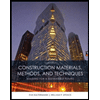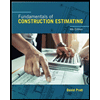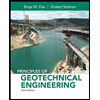![MindTap Engineering for Garber/Hoel's Traffic and Highway Engineering, 5th Edition, [Instant Access], 1 term (6 months)](https://www.bartleby.com/isbn_cover_images/9781305577398/9781305577398_largeCoverImage.gif)
Concept explainers
The structural components of a flexible pavement.
Explanation of Solution
The structural components of a flexible pavement are as follows:
- The subgrade or prepared roadbed,
- The subbase,
- The base and
- The surface course.
It is necessary to check for the evaluation of every component of the flexible pavement and
Subgrade (Prepared Roadbed)
It is first in the line of materials that are to be laid and serves as the foundation of the flexible pavement structure. It is being spread along the horizontal alignment of the pavement. The materials used in this layer are very well compacted to meet the prescribed specifications of strength. In this layer, borrow materials may also be used according to the pavement being constructed.
Subbase Course
This layer is kept above the subgrade and the materials used in this layer are of better quality as compared to that of the materials used in subgrade. The materials used in this flexible pavement structure must meet the specifications in terms of gradation, strength and plastic characteristics.
And in case, if the materials for the subbase course aren't readily available then the subgrade materials are treated to meet the specifications that of the subbase course material properties.
![MindTap Engineering for Garber/Hoel's Traffic and Highway Engineering, 5th Edition, [Instant Access], 1 term (6 months), Chapter 19, Problem 1P](https://content.bartleby.com/tbms-images/9781305156241/Chapter-19/images/html_56241-19-1p_1.png)
Base Course
This course comes at the third place in the line of pavement structures. It isplaced just above the subbase course and if subbase is not used then it lies immediately above the subgrade of the pavement structure. The materials that are used in this pavement section are of much better quality then those used in the previous layers in terms of gradation, strength and plastic requirements. Granular materials likestone,slag, gravel, and sand are used in this course of flexible pavement structure.Wherein, slag and gravel can be used in both forms i.e., (crushed or uncrushed) stones should be crushed. In case if some of the materials are not meeting the specifications for this line of course then they are used in the base if appropriately stabilized with Portland cement, lime or asphalt.For high quality pavements the material is treated with Portland cement or asphalt to improve the stiffness characteristics of such pavements.
Surface Course
This is the topmost layer of the flexible pavement and is placed above the base course of the road pavement. The materials in this pavement include a mixture of aggregates and asphalt. The properties of this material must be able to hold out against the high tire pressure, withstand abrasive forces due to the traffic flow, prevention against the infiltration of surface water to avoid rupturing of surface course and weakening of the underlying structural bed of the pavement. Considering the expected traffic flow the thickness of this layer varies from 3 inches to 6 inches.
Want to see more full solutions like this?
Chapter 19 Solutions
MindTap Engineering for Garber/Hoel's Traffic and Highway Engineering, 5th Edition, [Instant Access], 1 term (6 months)
- Why is it important for construction project managers to be flexible when dealing with the many variable factors that pop up in a project?arrow_forwardWhat are some reasons for why a company would accelerate a construction project?arrow_forwardFor the design of a shallow foundation, given the following: Soil: ' = 20° c' = 52 kN/m² Unit weight, y = 15 kN/m³ Modulus of elasticity, E, = 1400 kN/m² Poisson's ratio, μs = 0.35 Foundation: L=2m B=1m Df = 1 m Calculate the ultimate bearing capacity. Use the equation: 1 - qu = c' NcFcs Fcd Fcc +qNqFqsFqdFqc + ½√BN√Fãs F√dƑxc 2 For '=20°, Nc = 14.83, N₁ = 6.4, and N₁ = 5.39. (Enter your answer to three significant figures.) qu = kN/m²arrow_forward
- A 2.0 m wide strip foundation carries a wall load of 350 kN/m in a clayey soil where y = 15 kN/m³, c' = 5.0 kN/m² and ' = 23°. The foundation depth is 1.5 m. For ' = 23°: Nc = 18.05; N₁ = 8.66; Ny = = = 8.20. Determine the factor of safety using the equation below. qu= c' NcFcs FcdFci+qNqFqsFq 1 F + gd. 'qi 2 ·BN√· FF γί Ysyd F (Enter your answer to three significant figures.) FS =arrow_forward2P -1.8 m- -1.8 m- -B Wo P -1.8 m- Carrow_forwardPart F: Progressive activity week 7 Q.F1 Pick the rural location of a project site in Victoria, and its catchment area-not bigger than 25 sqkm, and given the below information, determine the rainfall intensity for ARI 5, 50, 100 year storm event. Show all the details of the procedure. Each student must propose different length of streams and elevations. Use fig below as a sample only. Pt. E-nt 950 200 P: D-40, PC-92.0 300m 300m 000m PL.-02.0 500m HI-MAGO PLA-M 91.00 To be deemed satisfactory the solution must include: Q.F1.1.Choice of catchment location Q.F1.2. A sketch displaying length of stream and elevation Q.F1.3. Catchment's IFD obtained from the Buro of Metheorology for specified ARI Q.F1.4.Calculation of the time of concentration-this must include a detailed determination of the equivalent slope. Q.F1.5.Use must be made of the Bransby-Williams method for the determination of the equivalent slope. Q.F1.6.The graphical display of the estimation of intensities for ARI 5,50, 100…arrow_forward
- I need help finding: -The axial deflection pipe in inches. -The lateral deflection of the beam in inches -The total deflection of the beam like structure in inches ?arrow_forwardA 2.0 m wide strip foundation carries a wall load of 350 kN/m in a clayey soil where y = 17 kN/m³, c' = 5.0 kN/m² and 23°. The foundation depth is 1.5 m. For o' = 23°: Nc = 18.05; N = 8.66; N = 8.20. Determine the factor of safety using the equation below. 1 qu = c' NcFcs Fed Fci +qNqFqs FqdFqi + ½ BN F√s 1 2 (Enter your answer to three significant figures.) s Fyd Fi FS =arrow_forward1.2 m BX B 70 kN.m y = 16 kN/m³ c' = 0 6'-30° Water table Ysat 19 kN/m³ c' 0 &' = 30° A square foundation is shown in the figure above. Use FS = 6, and determine the size of the foundation. Use the Prakash and Saran theory (see equation and figures below). Suppose that F = 450 kN. Qu = BL BL[c′Nc(e)Fcs(e) + qNg(e)Fcs(e) + · 1 YBN(e) F 2 7(e) Fra(e)] (Enter your answer to two significant figures.) B: m Na(e) 60 40- 20- e/B=0 0.1 0.2 0.3 .0.4 0 0 10 20 30 40 Friction angle, ' (deg) Figure 1 Variation of Na(e) with o' Ny(e) 60 40 20 e/B=0 0.3 0.1 0.2 0.4 0 0 10 20 30 40 Friction angle, ' (deg) Figure 2 Variation of Nye) with o'arrow_forward
- K/S 46. (O المهمات الجديدة 0 المنتهية 12 المغـ ۱۱:۰۹ search ليس لديك اي مهمات ☐ ○ ☑arrow_forwardI need help setti if this problem up and solving. I keep doing something wrong.arrow_forward1.0 m (Eccentricity in one direction only)=0.15 m Call 1.5 m x 1.5m Centerline An eccentrically loaded foundation is shown in the figure above. Use FS of 4 and determine the maximum allowable load that the foundation can carry if y = 18 kN/m³ and ' = 35°. Use Meyerhof's effective area method. For '=35°, N = 33.30 and Ny = 48.03. (Enter your answer to three significant figures.) Qall = kNarrow_forward
 Traffic and Highway EngineeringCivil EngineeringISBN:9781305156241Author:Garber, Nicholas J.Publisher:Cengage Learning
Traffic and Highway EngineeringCivil EngineeringISBN:9781305156241Author:Garber, Nicholas J.Publisher:Cengage Learning Construction Materials, Methods and Techniques (M...Civil EngineeringISBN:9781305086272Author:William P. Spence, Eva KultermannPublisher:Cengage Learning
Construction Materials, Methods and Techniques (M...Civil EngineeringISBN:9781305086272Author:William P. Spence, Eva KultermannPublisher:Cengage Learning Fundamentals Of Construction EstimatingCivil EngineeringISBN:9781337399395Author:Pratt, David J.Publisher:Cengage,
Fundamentals Of Construction EstimatingCivil EngineeringISBN:9781337399395Author:Pratt, David J.Publisher:Cengage, Principles of Geotechnical Engineering (MindTap C...Civil EngineeringISBN:9781305970939Author:Braja M. Das, Khaled SobhanPublisher:Cengage Learning
Principles of Geotechnical Engineering (MindTap C...Civil EngineeringISBN:9781305970939Author:Braja M. Das, Khaled SobhanPublisher:Cengage Learning



